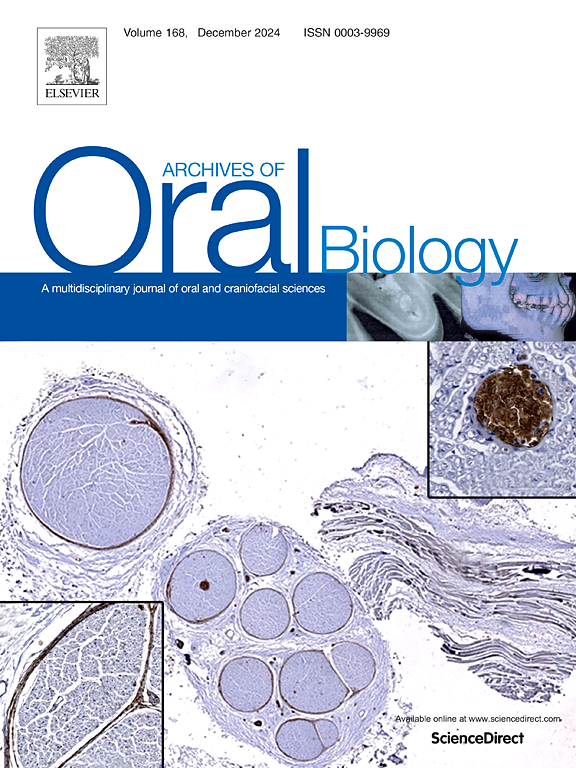贝伐单抗和细胞抑制剂诱导雄性大鼠颌下腺氧化变化
IF 2.2
4区 医学
Q2 DENTISTRY, ORAL SURGERY & MEDICINE
引用次数: 0
摘要
目的探讨贝伐单抗联合细胞抑制剂是否能引起动物颌下腺氧化反应。材料与方法雄性Wistar大鼠48只(350 ~ 400 g)。第一组:对照组;2组:5-氟尿嘧啶+ 亚叶酸钙(连续5天,20 mg/kg+10 mg/kg);3组:贝伐单抗,2次腹腔注射剂量0.2 mg/kg,第1天和第15天;第4组:奥沙利铂,1次腹腔注射剂量25 mg/kg,第1天和第15天;第5组:贝伐单抗+奥沙利铂+ 5-氟尿嘧啶+亚叶酸钙,单次腹腔剂量分别为20 mg/kg、10 mg/kg、0.2 mg/kg、25 mg/kg,第1天和第15天;第六组:配对喂养组,不给药。在颌下腺匀浆中,测定尿酸、脂质过氧化物、水性过氧化物和超氧化物歧化酶活性。结果:1、3、6组尿酸高于细胞抑制剂组(p <; 0.02、0.02、0.001)。脂质过氧化物和水过氧化物相似。2、3、4、5和6组的超氧化物歧化酶活性高于1组(p <; 0.0001)。第3组的超氧化物歧化酶活性低于细胞静态处理组,但高于第6组(p <; 0.001)。第2组的活性高于第3组和第6组(p <; 0.0001)。结论抑胞剂在腺泡水平上具有促氧化作用。相反,贝伐单抗可能促进抗氧化腺体反应。进一步研究这些治疗对口颌系统的影响对于改善接受抗肿瘤治疗的患者的生活质量至关重要。本文章由计算机程序翻译,如有差异,请以英文原文为准。
Bevacizumab and cytostatics induce oxidative changes in the submandibular gland of male rats
Objective
To investigate whether the administration of bevacizumab in combination with cytostatics could cause an oxidative response in the submandibular gland of an animal model.
Materials and methods
48 Male Wistar rats (350–400 g) were used. Group 1: Control; Group 2: 5-Flourouracil + Leucovorin calcium (Intraperitoneal injection for five consecutive days with 20 mg/kg+10 mg/kg); Group 3: Bevacizumab, two intraperitoneal doses of 0.2 mg/kg on days 1 and 15; Group 4: Oxaliplatin, one intraperitoneal dose of 25 mg/kg on days 1 and 15; Group 5: Bevacizumab+Oxaliplatin+ 5-Fluorouracil+Leucovorin calcium, single intraperitoneal dose of 20 mg/kg, 10 mg/kg, 0.2 mg/kg, and 25 mg/kg on days 1 and 15; Group 6: pair-fed group without drugs. In submandibular gland homogenates, Uric Acid, Lipid Peroxides, Aqueous Peroxides, and Superoxide Dismutase activity were measured. Results: Uric Acid in Groups 1, 3, and 6 were higher than in cytostatic groups (p < 0.02, 0.02, and 0.001). Lipid Peroxides and Aqueus Peroxides were similar. Superoxide Dismutase Activity was higher in Groups 2, 3, 4, 5, and 6 compared to Group 1 (p < 0.0001). In Group 3, Superoxide Dismutase Activity was lower than in cytostatic-treated groups but higher than Group 6 (p < 0.001). Group 2 showed higher activity compared to Groups 3 and 6 (p < 0.0001).
Conclusions
Cytostatic treatment exerted a pro-oxidant effect at the acinar level. Conversely, bevacizumab may promote an antioxidant glandular response. Further research into these treatments' effects on the stomatognathic system is crucial for improving quality of life in patients undergoing anti-tumour therapy.
求助全文
通过发布文献求助,成功后即可免费获取论文全文。
去求助
来源期刊

Archives of oral biology
医学-牙科与口腔外科
CiteScore
5.10
自引率
3.30%
发文量
177
审稿时长
26 days
期刊介绍:
Archives of Oral Biology is an international journal which aims to publish papers of the highest scientific quality in the oral and craniofacial sciences. The journal is particularly interested in research which advances knowledge in the mechanisms of craniofacial development and disease, including:
Cell and molecular biology
Molecular genetics
Immunology
Pathogenesis
Cellular microbiology
Embryology
Syndromology
Forensic dentistry
 求助内容:
求助内容: 应助结果提醒方式:
应助结果提醒方式:


